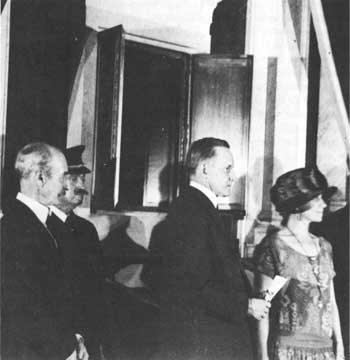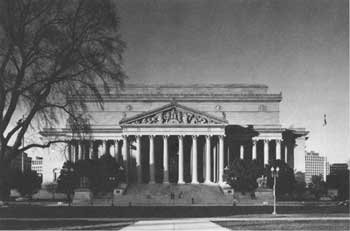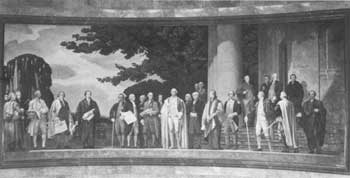







Text and History of Constitution
History of the Document
The veneration of the American people for the parchment, or engrossed, copies of the Declaration of Independence (1776), the Constitution (1787), and the Bill of Rights (1789) has been reflected in the painstaking care bestowed on them. After long odyssies, part of which they shared, today they are enshrined in Exhibition Hall of the National Archives Building. The Constitution and Bill of Rights, which were not regularly exhibited to the public until 1924 and 1952 respectively, are in far better physical condition than the Declaration, which has been displayed continuously since 1841 except for one period of three decades.
On September 20, 1787, Maj. William Jackson, secretary of the Constitutional Convention, delivered the engrossed copy of the Constitution to his counterpart in the Continental Congress, Charles Thomson, who already was responsible for safeguarding the Declaration of Independence. He likely stored the two documents first in City Hall, where Congress was meeting, and then between October 1788 and April 1789 at the two-room office on the southeast corner of Broad and Pearl Streets that Secretary for Foreign Affairs John Jay vacated for temporary use by the Continental Congress while City Hall (which became Federal Hall) was being renovated.
Although the new Government was formally launched when George Washington was inaugurated on the balcony of Federal Hall on April 30, 1789, Confederation officers maintained continuity until the Executive Branch could be organized, and Thomson probably moved into the hall with the new Congress. When he resigned on July 23, at Washington's request he turned over the Constitution and Declaration to Roger Alden, who had been Deputy Secretary of the Continental Congress.
The legislation creating the Department of State (September 15, 1789) charged it with the protection of important state papers. Accordingly, Acting Secretary John Jay who was in charge until appointee Thomas Jefferson could return from France and take over early in 1790, assumed jurisdiction over the Declaration and Constitution, and within a couple of weeks the newly issued parchment copy of the Bill of Rights. During this period, they were undoubtedly stored in the Department's temporary offices on lower Broadway.
In late 1790 the Government moved to Philadelphia. Except possibly for brief intervals when they may have been among the state papers evacuated to Trenton, N.J., during yellow-fever epidemics, the three documents remained there for a decade in successive State Department offices on Market Street, the southeast corner of Arch and Sixth Streets, on North Alley, and the northeast corner of Fifth and Chestnut Streets.
In 1800 the documents were shipped by sea to the new Capital, Washington, D.C. They were apparently kept for a couple of months in the Department's temporary offices in the old, or first, Treasury Building, just east of the White House at 15th Street and Pennsylvania Avenue NW., on the southern end of the site of the present Treasury Building; and then for a time at another temporary location, in one of the "Six Buildings," between 21st and 22d Streets on Pennsylvania Avenue NW. Likely in 1801 the Department relocated to the War Office Building, just west of the White House at 17th Street and Pennsylvania Avenue NW. The state papers remained there until late in August 1814, during the War of 1812, when British troops invaded the Capital. Shortly before they arrived, at the direction of Secretary of State James Monroe, the papers were packed in linen sacks and transported in carts to an unused gristmill belonging to an Edgar Patterson, on the Virginia side of the Potomac River about 2 miles above Chain Bridge. Before long, because a nearby cannon factory made the site a likely military target, a State Department clerk borrowed wagons from farmers in the, neighborhood and moved the papers to an empty house in Leesburg, Va., about 35 miles away. It was locked and the keys were given to a Reverend Littlejohn.
Within a few weeks, after the British had departed and the threat had subsided, in September 1814 the documents were brought back to Washington and temporarily kept at a private residence on the south side of G Street near 18th Street NW. that the State Department temporarily occupied until the fire-scarred War Office Building was ready for reoccupancy in April 1816.
In September 1819, the Department moved the Declaration, Constitution, and Bill of Rights to its new headquarters at 15th Street and Pennsylvania Avenue NW., on the north end of the site of the present Treasury Building. There they remained together until 1841, when the Declaration was taken away and displayed to the public at the New Patent Office Building.
In 1866 the Constitution and Bill of Rights were moved to premises the Department leased on 14th Street near S Street NW. In July 1875 they made their final move within the Department, to the partially completed State, War, and Navy Building (present Executive Office Building), at 17th Street and Pennsylvania Avenue NW. Two years later, the Declaration, which had just been exhibited in Philadelphia (1876-77) as part of the Centennial celebration of independence, rejoined the Constitution and Bill of Rights in the State, War, and Navy Building, though the Declaration continued to be displayed. By this time, its long exposure to sunlight, the making of various facsimiles, handling, and greater age had faded its ink considerably. In contrast, the Constitution and Bill of Rights, benefiting from their longtime obscurity, were in relatively good condition.
As a matter of fact, during the first century of existence of the parchment Copy of the Constitution, it had attracted virtually no public attention. Only in a few instances was it even inspected. For example, in 1823 Secretary of State John Quincy Adams and others examined it during a political dispute concerning its punctuation. A few years later, James Madison, "Father of the Constitution" and its onetime custodian as Secretary of State (1801-9) expressed uncertainty as to its location. In 1846 a publisher used it to prepare a book on the Constitution. When historian J. Franklin Jameson examined the parchment in 1883, he found it folded in a small tin box in the bottom of a closet at the State, War, and Navy Building.
In 1894, noting the deterioration in the Declaration, the State Department sealed it and the Constitution between two glass plates and locked them in a safe or steel case in the basement, apparently along with the Bill of Rights. There they lay, except on rare occasions, unobserved and in darkness for a quarter of a century. In 1921, in response to a Presidential Executive order, which reflected the findings of a special committee, the Department, though it retained control of the Bill of Rights, relinquished the Constitution and Declaration to the Library of Congress, where they could receive expert care and be safely exhibited to the public.
 |
| In February 1924 President and Mrs. Calvin Coolidge dedicated the newly completed shrine in the Library of Congress that contained the Constitution and the Declaration of Independence. Dr. Herbert Putnam, Librarian of Congress, is at the left. (National Archives (1924).) |
Herbert Putnam, the Librarian, personally made the transfer in a library mail truck, a Model T Ford. At first, he kept the documents in a safe in his office. In 1924, however, he put them on public display on the second floor of the present main building in a bronze-and-marble shrine. Placed over special moisture-absorbing cellulose paper, they were sealed between double panes of insulated plate glass, from which the air was expelled and just under which gelatin film kept out harmful rays of light.
The Constitution and Declaration remained there until December 26, 1941, just 19 days after Japan attacked Pearl Harbor. Packed in acid-free paper and rock wool in a hermetically sealed bronze container, they left Washington by train in a Pullman compartment under Secret Service guard en route to the United States Bullion Depository, Fort Knox, Ky. They arrived there the following day and were placed in a vault. Taking advantage of the opportunity, specialists cleaned and restored the documents to the maximum degree. On September 29, 1944, with the approval of the Joint Chiefs of Staff, they were returned to the Library of Congress and on October 1 were reexhibited.
In 1951, based on the results of a long study that the National Bureau of Standards had initiated at the request of the Librarian of Congress to determine the best possible protection from the atmosphere, insects, mold, and light, each of the six leaves of the two instruments were sealed in separate cases fitted with glass and special filters that screened out damaging light rays. The helium atmosphere was inert and properly humidified.
In December 1952 the two documents were transported in wooden boxes atop mattresses in an armored troop carrier under military escort to their permanent home, the National Archives Building. It had been completed in 1935 as the repository for official governmental records, which are under the jurisdiction of the National Archives and Records Service of the General Services Administration. A special hall had been designed to safeguard and exhibit the most famous of the Nation's documents. The Bill of Rights had already been shipped to the National Archives Building from the State, War, and Navy Building in 1938; during the interim, it was not permanently displayed.
| ADDITIONAL INFORMATION |
| The Charters of Freedom |
Still enshrined at the National Archives Building today, along with thousands of other priceless national records, are the parchment copies of the Declaration, Constitution, and Bill of Rights. The massive bronze doors at the Constitution Avenue entrance to the building lead to the circular Exhibition Hall. At its rear center stands a marble shrine containing the Declaration; the first and fourth, or signature, pages of the Constitution; and the Bill of Rights. Every Constitution Day (September 17) the first four pages of the Constitution are all displayed together in a portable exhibit case in the center of the rotunda.
 |
| National Archives Building, where the Constitution reposes today. (National Park Service (Boucher, 1975).) |
At other times, the second and third pages, as well as the rarely displayed fifth and last page of the Constitution (known as the "Resolution of Transmittal to the Continental Congress"), are safeguarded in the vault below. On the fifth page, signed by Washington, he detailed the steps required for adoption of the new plan of Government, including the ratification process.
The Bill of Rights on display, which lists the first 12 proposed constitutional amendments, only the last 10 of which the States ratified, is the enrolled parchment copy of the congressional resolution of September 25, 1789, engrossed by House Clerk William Lambert. Thirteen other parchment copies, differing only in such details as handwriting, capitalization, and lineation, were transmitted to the States for ratification; only a few of these have survived.
When not exhibited, the Nation's most precious documents are secured in a fireproof, shockproof, bombproof vault, which is constructed of steel and reinforced concrete and is located below the shrine under the floor of Exhibition Hall. An electrical mechanism automatically lowers them into the vault and raises them back to their positions in the shrine. Other machinery then closes a massive lid of metal and concrete over the vault. These mechanisms can be activated in the event of danger; and, during a power failure, may be operated manually.
Along both sides of the bulwark charters is a "Formation of the Union" display. It consists of documents illustrating the evolution of the U.S. Government from 1774 until 1791. Included are the Articles of Association (1774), the Articles of Confederation (1778), the Treaty of Paris (1783), and Washington's inaugural address (1789).
On each wall above the exhibit is a mural. In one, Jefferson and the drafting committee are presenting the Declaration to John Hancock, President of the Continental Congress. In the other, James Madison, accompanied by various members of the Constitutional Convention, is submitting the Constitution to George Washington, the Convention's presiding officer.
 |
| Barry Faulkner's mural depicting Madison and 23 Convention delegates submitting the Constitution to Washington, president of the Convention. (National Archives.) |
 |
 |
http://www.cr.nps.gov/history/online_books/constitution/history.htm
Last Updated: 29-Jul-2004